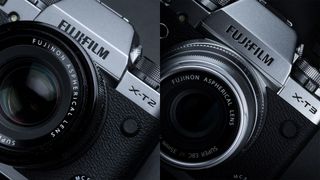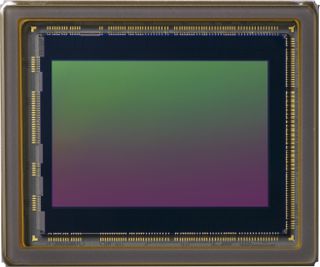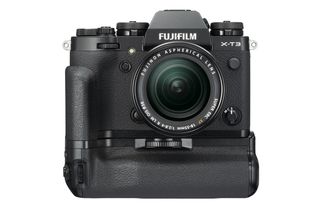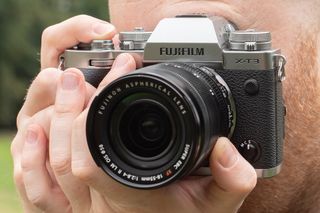Fujifilm X-T3 vs X-T2: 10 key differences you need to know
Is the new X-T3 a marked improvement on the X-T2?

It's tricky to think of a camera line that has resonated with the enthusiasts and pros more so than Fujifim's X-series, and its X-T models in particular have been big smashes.
Blending X-Trans CMOS sensor technology, Film Simulation modes and a centrally positioned electronic viewfinder together with masses of manual control – and all inside a handsome, rugged body – was always going to be a winning formula, but things move quickly in two years and the new X-T3 delivers a wealth of improvements over the much-loved, still-coveted X-T2.
What follows is not a complete list of changes between the two, as we'd be here for some time. Rather, we investigate the major revisions between the two in the key areas.
- Read our hands on Fujifilm X-T3 review
Fujifilm X-T3 vs X-T2: sensor
Fujifilm has relied upon 24MP sensors for its most recent models, many based on the X-Trans CMOS architecture, and the X-T2 was one recipient of this. The X-T3, however, has the honor of being the first model to sport a fourth-generation version of the X-Trans technology.
The X-Trans CMOS 4 sensor still has the same APS-C dimensions as before, although its structure is quite different. It boasts a back-illuminated design – not something we've seen on an APS-C camera since the now-departed Samsung NX1 – to allow for better light gathering than would be otherwise possible, and copper wiring has also been used to help boost readout speeds and further reduce noise.

It also upps the pixel count to 26.1MP, which is higher than any other camera in the X Series range, and also now has a lower base sensitivity of ISO160 (rather the the X-T2's ISO200). 2.16million of these pixels are also now charged with phase-detect AF duties, which we'll investigate in a second.
Fujifilm X-T3 vs X-T2: processor
While the X-T2 offered the same X-Processor Pro engine that starred in the X-Pro2 – and more recently the flagship X-H1 and medium format GFX 50S (below) models – the X-T3 introduces a fresh engine to the X series.
Get daily insight, inspiration and deals in your inbox
Get the hottest deals available in your inbox plus news, reviews, opinion, analysis and more from the TechRadar team.
X-Processor 4 features a Quad Core CPU, which boosts processing speeds to three times that of the previous engine. In addition, this allows for faster autofocus and better accuracy, together with fresh video options and changes to the Film Simulation modes. It also enables user to apply the Color Chrome Effect mode, which was previously only seen on the GFX 50S, to be applied to both individual images and bursts.

Fujifilm X-T3 vs X-T2: autofocus
Aside from the X-T3's new sensor and processor, it's the autofocus system that has arguably seen the biggest changes over the X-T2. In fact, it's partly because of the new sensor and processor that the autofocus system leaps forward as much as it does.
For a start, the X-T3's sensor boasts more than four times the number of phase-detect AF pixels as the 500,000 on the X-T2's sensor, now numbering 2.16-million. These stretch across almost the entire frame so that the system can sense subjects pretty much wherever they may be.
This density is also said to help the new camera achieve a lower working range of -3EV (against the X-T2's 1EV rating, following a firmware update), and it should also help with tracking moving subjects.
The processor is also behind a 50% increase in autofocus and metering frequency, so that the camera can more accurately lock focus and get exposure spot on, even against moving subjects. Face and eye detection are also said to be improved, with the latter working when the camera is set to AF-C to keep a lock wherever the subjects moves to.
The X-T2 allows you to manually address 325 points while the X-T3 adds a hundred to make 425. That's quite a lot of shifting, but you can scale this down to 91 and 117 respectively if you find this to be overkill.

Fujifilm X-T3 vs X-T2: burst shooting speed
The X-T2 has a very respectable 8fps burst-shooting option, which can be boosted to 11fps when using the optional Vertical Booster Grip. Switch to the electronic shutter and the Boost mode, however, and you can fire at 14fps without any additional accessories.
This is no doubt more than enough for most applications, but the X-T3 once again trounces its forebear. A standard 11fps burst shooting option gives it a 3fps advantage with the mechanical shutter, and this can be boosted to 20fps when the electronic shutter is employed. You can also use the X-T3 with its own Vertical Grip (below), although this doesn't increase burst speed as the X-T2's does.
The X-T3 has a further trick, however, namely the Sports Finder mode. This uses a crop of 1.25x to speed things up even further to a maximum 30fps. The only caveat here is that images are output at 16.6MP rather than 26.1MP, though for most uses this will no doubt be sufficient.

Fujifilm X-T3 vs X-T2: EVF
The X-T2's electronic viewfinder features the familiar 2.36-million dots spread across an OLED panel, and has a magnification of 0.77x. This is perfectly respectable for a mirrorless model of the X-T2's calibre, but the X-T3 is launched at a time where things have moved on from this.
Much like the Panasonic GH5S, Canon EOS R and Nikon Z7, the X-T3 has a 3.69-million dot panel inside its viewfinder. At 0.75x, its magnification is actually a little lower than before, but not by much.
The finder offers the same 100fps refresh rate as the panel inside the X-T2, but only when using the camera in its Boost mode; otherwise, the refresh rate is 60fps. Display lag time is also unchanged between the two, at a super-fast 0.005sec.
Incidentally, this isn't the first time we've seen a 3.69million dot viewfinder on a Fujifilm camera. The GFX 50S also benefits from an EVF with the same resolution, and a slightly higher magnification of 0.82x, but this is a removable viewfinder, rather than one incorporated into the camera itself.

Fujifilm X-T3 vs X-T2: size and weight
The X-T3's spec sheet shows that it's put on a little weight over the X-T2, with a weight of 539g with its battery and card in place. That said, this isn't perceptible and so it won't make any difference in the hand. This is possibly explained by the fact that the X-T3 is almost 1cm deeper and 1mm taller then the X-T2.
Fujifilm X-T3 vs X-T2: video features
The X-T2 was already capable of capturing UHD 4K video upon its release, and a firmware update allowed it to access the F-Log shooting profile and high-speed video at up to 120fps with 1080p output. So, if even Fujifilm hadn't changed too much here, the X-T3 would have probably remained a tempting option for videographers.
And yet, it did. The X-T3 can record UHD 4K and DCI 4K footage at up to 60p, at 10-bit with 4:2:0 chroma sub-sampling internally, and can output the same resolution and frame rate (albeit with 4:2:2 sampling) through its micro HDMI port. The X-T2, meanwhile, manages 4K/30p recording at 8-bit with 4:2:0 sub-sampling internally, and 4:2:2 8-bit output through its HDMI port.
The X-T3 user can also now choose between H.264/MPEG-4 and H.265/HVEC codecs, and rolling shutter is said to have been reduced down to 17ms, while the ETERNA/Cinema Film Simulation mode is also an option on the new arrival. A firmware update later this year is also set to make the camera support Hybrid Log Gamma (HLG).
While the X-T3 applies a small 1.18x crop when capturing 4K footage at 60p, this disappears at 30p (which, on the X-T2, was subject to a 1.17x crop factor). A new 4K interframe NR noise reduction feature is said to help reduce noise at ISO 12,800 by two stops on the X-T3.
This wealth of changes is impressive. Of course, now that we've seen so much of a shift between the two cameras, it's possible some of what can be gifted to the X-T2 may well end up on that camera through a firmware update.
Fujifilm X-T3 vs X-T2: color options
The X-T2 features 15 Film Simulation settings, which include the various filter options that can be applied to images captured in the Monochrome and ACROS styles. The new X-T3 mirrors these, but also adds the video-centric ETERNA/Cinema option that we first saw in the X-H1.
Two further changes split the newer X-T3 from the X-T2. First, the Color Chrome effect that we first saw in the GFX 50S has also made the cut on the newer model. This option aims to clarify details in very saturated subjects – such as flowers with only one dominant hue, which can be difficult to render – and you can set this to either Weak or Strong settings.
The second change on the X-T3 concerns toning effects when shooting black-and-white images. When the camera is set to either the Monochrome or ACROS options, you have access to a slider that lets you inject a cooler or warmer cast (below) into images. You can travel each way in fine increments to lend images either a more subtle tint or something more pronounced.

Fujifilm X-T3 vs X-T2: ports
Fujifilm has made a number of small changes to the X-T3's ports and connectivity options from the X-T2, and, depending on how you work, you may find some of these to be significant.
In place of the X-T2's micro USB 3.0 port, for example, the X-T2 sports a USB 3.1 Type C port, although both cameras share the same micro (Type D) HDMI port.
The presence of both 3.5mm microphone and headphone ports on the X-T3 will be a welcome change for videographers, as the previous X-T2 lacks a headphone port. The only way around this is to use the port on the Vertical Booster Grip, but not everyone will be prepared to buy it for this purpose alone.
The door to these ports on the X-T3 can also be removed, something that wasn't possible on the X-T2. This allows a number of cables to be used at the same time without the door being in the way.

Fujifilm X-T3 vs X-T2: battery performance
Despite the use of the same NP-W126S battery, it appears that the newer processor is able to squeeze out a little extra juice for the newer camera.
While the X-T2 can manage 340 frames on a single charge, the X-T3 promises to last for 390. Shooting video instead? Times don't differ too greatly here, with each model having a five minute advantage or disadvantage over the other, depending on whether you're capturing in 4K or Full HD, and whether you've enabled Face detection.
If you are worried about battery life, you can either pack an additional battery or use either model with a dedicated grip, with a total of 1,000 and 1,100 frames on the X-T2 and X-T3 respectively.
Most Popular


